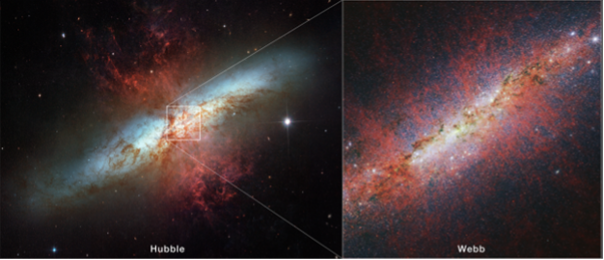Galaxy Evolution
The Galaxy Evolution team, led by Chief Investigator, Deanne Fisher, to understand:
-
- how chemical elements accumulate in galaxies and their surroundings;
- how visible and dark matter assemble within galaxies; and
- how ionising radiation is produced and escapes galaxies
over 13 billion years of cosmic time.
This project includes the First Galaxies program with nearby galaxies observed with SAMI and Hector, and complements ASKAP observations of the cool gas in galaxies.
The search for distant galaxies
To form a comprehensive picture of how galaxies formed and evolved, the ASTRO 3D Galaxy Evolution (GE) Project tracks how gas, stars, and dark matter evolve by combining deep spectroscopy with multi-wavelength imaging. The GE Project is unified behind three primary themes focussed on ionisation, chemical evolution, delivering a unique portfolio that bridges individual stars to the most massive galaxies.
Building on the GE team’s extensive experience, we capitalise on Australia’s access to 8 – 10m class telescopes to obtain innovative observations that test cutting-edge cosmological simulations. By weaving together small- to large-scale projects developed across the A3D institutions, the GE Project:
- applies advanced data mining techniques to large surveys, e.g. the Dark Energy Survey, to comb through large cosmic volumes and discover rare gravitational lenses;
- uses powerful telescopes to measure the build-up of cosmic mass in lensed galaxies and gain a magnified view of their chemical evolution and ionisation;
- determine the composition and state of the diffuse material in intergalactic space with absorption-line spectroscopy of distant quasars; and
- study Lyman continuum (ionising) galaxies to measure the escape fractions of ionising radiation, a crucial parameter for the Genesis Simulations.
The discoveries by the GE Project help understand the foregrounds in the MWA EoR data, and their history will be compared with the archaeological history of the Milky Way from the GALAH survey. Our studies also include the First Galaxies by observing nearby galaxies with SAMI and Hector, and complements ASKAP observations of the cool gas in galaxies. We also train emerging leaders to design projects for the exciting next generation of international observatories coming online in the next decade, e.g. the GMT, E-ELT, LSST, and JWST.
Gravitational lensing
Searching for the first galaxies means looking for sources so distant that their light has travelled for more than 13 billion years before it has reached us.
As the light emitted by distant galaxies passes by massive objects in the universe, the gravitational pull from these objects can distort or bend the light. This is called gravitational lensing. Weak gravitational lensing results in galaxies appearing distorted, stretched or magnified. Although difficult to measure for an individual galaxy, galaxies clustered close together will exhibit similar lensing patterns.
The search for the first galaxies
To find these exceptionally faint, distant galaxies, our astronomers use the Hubble Space Telescope. They were awarded 500 Orbits in 2017. CI Michele Trenti and his international Brightest of Reionising Galaxies (BoRG) survey team searched for galaxies within the first 700 million years after the Big Bang. The data was acquired over 18 months using a new multi-colour imaging technique. The team has analysed primarily infrared images from Hubble’s Wide Field Camera 3.
Spotting these first galaxies is not always easy, and sometimes relatively nearby objects (only 7-9 billion light years away) masquerade as “imposters” with similar appearance and colour. However, the team’s optimised observational strategy that involves following-up sources to measure their colours more accurately purifies the sample efficiently. In 2018, the team discovered that BoRG 0116+1425 630 galaxy is likely to be an “interloper”, relatively nearby and much younger than previously thought.
The First Galaxies team is also using computational modelling of the first galaxies clustering and also the connection between the dark matter halo assembly and galaxy luminosity function evolution. These simulations will help train neural networks that will be applied to the search catalogue to find better candidate galaxies to observe.
GALAXY EVOLUTION SURVEYS
ASTRO 3D Galaxy Evolution Team members now lead several large surveys of galaxies. Click on the links below to find out more:
galaxy evolution project leadership
latest in galaxy evolution
A galactic conspiracy disproven
Stars and dark matter are not interacting in 'impossible ways'. A longstanding ‘conspiracy’ in astronomy – that stars and dark matter are interacting in inexplicable ways – has been overturned by an international team [...]
Fantastic molecular outflows and how to find them
Physical processes within a galaxy can launch gas into outflows, acting as conduits for the exchange of mass and energy between a galaxy and its surroundings. Physical processes within a galaxy can launch gas [...]
Evolving star formation patterns in starburst galaxies over time
Starburst galaxies, which are characterised by a high rate of star formation, are found to form stars differently across cosmic time. In the past, these galaxies formed new stars evenly throughout their entire structures, [...]
NASA’s JWST probes an extreme starburst galaxy
On the left is the starburst galaxy M82 as observed by NASA’s Hubble Space Telescope in 2006. The small box at the galaxy’s core corresponds to the area captured so far by the NIRCam [...]








